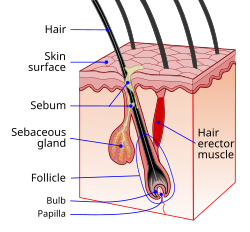In Which Layer Of The Skin Are Sebaceous Glands Located?
« Dorsum to Glossary Alphabetize

What is the Sebaceous gland?
Sebaceous glands are exocrine glands that release sebum. These glands are continued with the hair follicles, and, in about cases, sebum is released through the aforementioned pore through which hair grows. Sebaceous glands are located on every surface of your skin, with the exception of your palms, bottom lip, and the soles of your anxiety.
Sebum is a fatty substance secreted by the sebaceous glands in the peel. It consists mainly of fatty acids, waxes, triglycerides, and cholesterol. The substance is secreted to the surface of the skin via the small ducts that lead to the hair follicles.
Sebum is i of many oily substances associated with the skin'southward surface. More sebaceous glands can be establish on the forehead and chin than in other areas of the face. For this reason, the face's sebum levels are more pronounced in these areas.
Nether normal circumstances, sebum provides the pare with a sparse film, which protects the skin from drying. It also has an antibacterial effect to help protect the skin from microbial assault. Overproduction of sebum, which is associated with an oily pare status, can beal the skin and pb to the evolution of blackheads, whiteheads, and full-blown acne.
It is interesting to notation that sebum is linked to humans' odor profile and that its smell tin can exist detected by certain canines. It is besides believed that this profile might take played a function in archaic homo's communication with his peers.
Sebaceous_gland (Wikipedia)
| Sebaceous gland | |
|---|---|
 Schematic view of hair follicle and sebaceous gland. | |
 Cross-section of all skin layers. A hair follicle with associated structures. (Sebaceous glands labeled at center left.) | |
| Details | |
| Identifiers | |
| Latin | glandula sebacea |
| MeSH | D012627 |
| TA | A16.0.00.03 |
| FMA | 59160 |
| Anatomical terminology [edit on Wikidata] | |
Sebaceous glands are microscopic exocrine glands in the pare that secrete an oily or waxy matter, called sebum, to lubricate and waterproof the skin and hair of mammals. In humans, they occur in the greatest number on the confront and scalp, but besides on all parts of the skin except the palms of the hands and soles of the feet. The type of secretion of the sebaceous glands is referred to equally holocrine. In the eyelids, meibomian glands, also called tarsal glands, are a blazon of sebaceous gland that secrete a special type of sebum into tears. Fordyce spots are ectopic (misplaced) sebaceous glands constitute usually on the lips, gums and inner cheeks, and genitals. Areolar glands surround the female nipples.
Several related medical conditions involve sebum—including acne, sebaceous cysts, hyperplasia, and sebaceous adenoma. These are usually attributable to overactive sebaceous glands, which produce excess sebum.
« Dorsum to Glossary Alphabetize
Source: https://www.theskincarechemist.com/glossary/sebaceous-gland/
Posted by: pomeroysaps1951.blogspot.com


0 Response to "In Which Layer Of The Skin Are Sebaceous Glands Located?"
Post a Comment